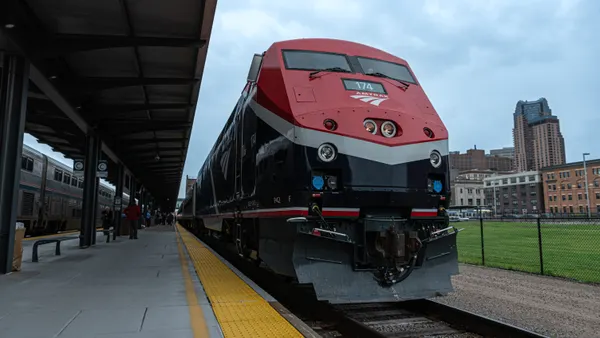Dive Brief:
- Most cities are not doing enough to develop substantial mass transit systems despite continued population growth and concerns over the effects of climate change, according to a new report from the Institute for Transportation and Development Policy (ITDP), entitled "Indicators for Sustainable Mobility."
- Using census and employment data, ITDP established 12 benchmarks for how transit serves city residents, including connections to jobs, frequency and speed. It found cities in the United States are far behind their counterparts in Canada and Mexico, with only Minneapolis, Boston, Chicago, New York, Philadelphia, Seattle and Washington, DC serving 70% or more of their populations, jobs and low-income households with good quality transit.
- "We know what happens when cities grow without a solid plan for transport, because we’re seeing it now in some of the fastest-growing cities of both the Global South and southern US," Joe Chestnut, author of the ITDP report, said in a statement. "Without alternatives, middle-class wage earners become increasingly dependent on their cars, spending more and more time stuck in traffic, and less wealthy communities simply lose access to the city."
Dive Insight:
The report paints something of a gloomy picture of the state of transit in U.S. cities, which the report finds are still far too reliant on personally-owned vehicles, despite worries about congestion and the impact on the fight against climate change.
ITDP noted the likes of Memphis, TN, San Antonio and Nashville, TN as some of the worst offenders in being almost totally dependent on cars. In low-income communities especially, that puts many job opportunities out of reach and makes it difficult to carry out even simple tasks like getting to school or medical appointments.
"In the U.S., there is a narrative that if people work hard, then they can get out of poverty, but we’ve built cities that make this narrative impossible,” Chestnut said.
Minneapolis came in for special praise in part due to its ambitious "Minneapolis 2040" plan, which encourages transit-oriented development and calls for investments in bike facilities and trails among others. It increased the number of people that live near frequent transit from 64% to 73%, the largest jump among the cities that ITDP evaluated. "Minneapolis has very intentionally tied transportation and land use decisions together in policy, focusing growth near transit and prioritizing infrastructure improvements in growing parts of the city," Minneapolis City Council President Lisa Bender said in a statement.
The report indicates there is more work to be done, especially for cities that are at the lower end of the spectrum. Nashville had an ambitious transit plan rejected by voters last year, a referendum result that has led to a great deal of soul-searching among city officials. The American Public Transportation Association (APTA) has been a strong advocate for transit, saying greater use will cut road deaths, and urging more government spending to improve options.
But public transit ridership continues to fall, not only because of the increasing number of options like ride-hailing, dockless bikes and scooters and other forms of vehicle sharing. APTA figures released earlier this year found a 1.75% drop in total ridership in the third quarter of 2018 compared to the third quarter of 2017. Given that, it could be difficult for cities to justify continued investment, but residents require options to get around without having to own a car, and transit is one.












